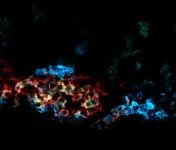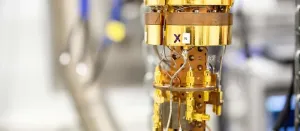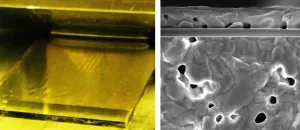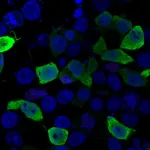(Press-News.org) Losing Key Type of Pancreatic Cell May Contribute to Diabetes
Multiple types of beta cells produce insulin in the pancreas, helping to balance blood sugar levels. Losing a particularly productive type of beta cell may contribute to the development of diabetes, according to a new study by Weill Cornell Medicine investigators.
In the study, published March 16 in Nature Cell Biology, Dr. James Lo, associate professor of medicine at Weill Cornell Medicine, and colleagues measured gene expression in individual beta cells collected from mice to determine how many different types of beta cells exist in the pancreas. The team discovered four distinct beta cell types, including one that stood out. The cluster 1 group of beta cells produced more insulin than other beta cells and appeared better able to metabolize sugar. The study also showed that loss of this beta cell type might contribute to type 2 diabetes.
“Before this, people thought a beta cell was a beta cell, and they just counted total beta cells,” said Dr. Lo, who is also a member of the Weill Center for Metabolic Health and the Cardiovascular Research Institute at Weill Cornell Medicine and a cardiologist at NewYork-Presbyterian/Weill Cornell Medical Center. “But this study tells us it might be important to subtype the beta cells and that we need study the role of these special cluster 1 beta cells in diabetes.”
Drs. Doron Betel, Jingli Cao, Geoffrey Pitt and Shuibing Chen at Weill Cornell Medicine teamed up with Dr. Lo to carry out the study.
The investigators used a technique called single-cell transcriptomics to measure all the genes expressed in individual mouse beta cells and then used that information to group them into four types. The cluster 1 beta cells had a unique gene expression signature that included high expression of genes that help cellular powerhouses called mitochondria to break down sugar and power them to secrete more insulin. Additionally, they could distinguish the cluster 1 beta cells from the other beta cell types by its high expression of the CD63 gene, which enabled them to use the CD63 protein as a marker for this specific beta cell type.
“CD63 expression provided us a way to identify the cells without destroying them and allowed us to study the live cells,” he said.
When the team looked at both human and mouse beta cells, they found that cluster 1 beta cells with high CD63 gene expression produce more insulin in response to sugar than the three other types of beta cells with low CD63 expression.
“They are very high-functioning beta cells,” Dr. Lo said. “We think they may carry the bulk of the workload of producing insulin, so their loss might have profound impacts.”
In mice fed an obesity-inducing, high-fat diet and mice with type 2 diabetes, the numbers of these insulin-producing-powerhouse beta cells decreased.
“Because the numbers of cluster 1/high CD63 cells went down, you may have less insulin production, which may play a major role in diabetes development,” he said.
Transplanting beta cells with high CD63 production into mice with type 2 diabetes restored their blood sugar levels to normal. But removing the transplanted cells caused high blood sugar levels to return. Transplanting low CD63 production beta cells into the mice didn’t restore blood sugar to normal levels. The transplanted low CD63 beta cells instead appeared dysfunctional.
The discovery may have important implications for the use of beta cell transplants to treat diabetes, Dr. Lo said. For example, it may be better to transplant only high CD63- beta cells. He noted that it might also be possible to transplant fewer of these highly productive cells. Dr. Lo’s team also found that humans with type 2 diabetes had lower levels of high CD63 beta cells compared to those without diabetes.
Next, Dr. Lo and his colleagues would like to find out what happens to the high CD63-producing beta cells in mice with diabetes and how to keep them from disappearing.
“If we can figure out how to keep them around longer, surviving and functional, that could lead to better ways to treat or prevent type 2 diabetes,” he said.
They would also like to study how existing diabetes treatments affect all types of beta cells. GLP-1 agonists, which help increase the release of insulin in people with diabetes, interact with high and low CD63-producing beta cells.
“Our study also shows that GLP-1 agonists might also be a way to get the low CD63-producing beta cells to work better,” Dr. Lo said.
Many Weill Cornell Medicine physicians and scientists maintain relationships and collaborate with external organizations to foster scientific innovation and provide expert guidance. The institution makes these disclosures public to ensure transparency. For this information, see profile for Dr. Lo.
END
Losing key type of pancreatic cell may contribute to diabetes
2023-03-16
ELSE PRESS RELEASES FROM THIS DATE:
Spin-off: 12 million euros for a novel gene editing platform
2023-03-16
The TU Dresden Spin-off Seamless Therapeutics Launches with $12.5M Seed Financing to Advance Transformative Gene Editing Platform Based on Programmable Precision Designer Recombinases in Dresden
Seed round co-led by Wellington Partners and Forbion, with additional non-dilutive financial support from the BMBF (GO-Bio funding) enables maturation of the proprietary platform and pipeline towards first clinical evaluation
Seamless Therapeutics, a Dresden based start-up of the Technische Universität Dresden, today announced a $12.5 million (€11.8M) seed financing round which will accelerate further development ...
Paxlovid associated with lower risk of hospital admission
2023-03-16
PASADENA, Calif. — A Kaiser Permanente study confirms the benefit of nirmatrelvir-ritonavir, also known as Paxlovid, as an early-stage treatment to prevent hospitalization for people with mild to moderate COVID-19, regardless of prior immunity or age. The study was published March 15, 2023, in Lancet ID.
“Among Kaiser Permanente members in Southern California who tested positive for coronavirus infection, receiving Paxlovid within 5 days of the start of COVID-19 symptoms was associated with substantial reductions in the risk of hospital admission or death,” said Sara Tartof, PhD, the senior author of the study and an epidemiologist with the Kaiser ...
Children at risk of multiple sclerosis often go undetected in early stages
2023-03-16
Criteria used by neurologists to assess for multiple sclerosis (MS) in adults may fail to identify the illness in children with imaging suspicious for the disease, an oversight that could delay treatment of the disease at its earliest stages, according to a Rutgers study.
Magnetic resonance imaging (MRI) is the primary tool used for diagnosis of MS, and doctors have applied various standards over the years to classify those most likely to develop the disease. The most recent standard, known as the McDonald criteria, was last updated in 2017.
In some cases, imaging suspicious for MS is found incidentally ...
Breakthrough in the understanding of quantum turbulence
2023-03-16
Researchers have shown how energy disappears in quantum turbulence, paving the way for a better understanding of turbulence in scales ranging from the microscopic to the planetary.
Dr Samuli Autti from Lancaster University is one of the authors of a new study of quantum wave turbulence together with researchers at Aalto University.
The team’s findings, published in Nature Physics, demonstrate a new understanding of how wave-like motion transfers energy from macroscopic to microscopic length scales, and their results confirm ...
Selwyn Rogers named associate editor of prestigious New England Journal of Medicine
2023-03-16
Renowned University of Chicago Medicine trauma surgeon Selwyn O. Rogers Jr., MD, MPH, has been named an associate editor of the New England Journal of Medicine (NEJM), effective March 16.
The founding director of the UChicago Medicine Trauma Center, Rogers is a Professor of Surgery at UChicago and Chief of Trauma and Acute Care Surgery at its 1,296-bed academic health system based on Chicago’s South Side.
A leading public health expert whose research focuses on the healthcare needs of underserved populations — particularly those impacted by intentional violence — he is the first surgeon in more than a decade to serve as an associate editor at NEJM, ...
Perovskite solar cells from the slot die coater - a step towards industrial production
2023-03-16
Metal halide perovskites are considered to be a particularly low-cost and promising class of materials for next-generation solar modules. Perovskite solar cells can be produced with coating processes using liquid inks made from precursor materials and various solvents. After coating, the solvents evaporate and the perovskites crystallise to form a more or less homogeneous layer.
Options for upscaling
Prof. Dr. Eva Unger's team at Helmholtz-Zentrum Berlin has extensive expertise in solution-based processing methods and is investigating options for upscaling. "Perovskite photovoltaics is the best solution-processable PV technology available," says Eva Unger, ...
Researchers highlight nucleolar DNA damage response in fight against cancer
2023-03-16
Cancer, which affects millions every year, requires proteins to spread through the body. In a new strategy to beat the wide-ranging disease, scientists are sabotaging its protein factories.
In a new forum paper published in Trends in Biology, researchers from the University of North Carolina at Charlotte encapsulated the young field of nucleolar DNA damage response (DDR) pathways. The review highlights six mechanisms by which cells repair DNA damage, including one which was published five months ago in Nucleic Acids Research by the same authors. By attacking these mechanisms, future applied researchers will be able to ...
Food security: New tool can forecast food insecurity up to 30 days in advance
2023-03-16
A new tool that can be used to forecast the prevalence of individuals within a country that may have insufficient access to food — known as food insecurity — up to 30 days into the future is presented in a study published in Scientific Reports. The authors suggest that the tool could aid decision makers in countries at risk of food insecurity and help facilitate more timely responses.
Elisa Omodei and colleagues developed the tool using food consumption data from Burkina Faso, Cameroon, Mali, Nigeria, Syria and Yemen — all countries that have recently ...
Study of immune ‘neighborhoods’ highlights macrophages as key players in invasive breast cancers
2023-03-16
Most immunotherapies, which aim to boost T cell activity, work poorly in treating estrogen receptor-positive (ER+) breast cancer. Targeting a different type of immune cell called macrophages could be a more effective approach, suggests a comprehensive new analysis of invasive ER+ breast cancers led by University of Pittsburgh School of Medicine scientists.
Published today in Nature Cancer, the study found that macrophages were the dominant immune cell infiltrating ER+ invasive lobular carcinoma (ILC) and invasive ductal carcinoma ...
Genetic causes of three previously unexplained rare diseases identified
2023-03-16
New York, NY (March 16, 2023) – Using a new computational approach they developed to analyze large genetic datasets from rare disease cohorts, researchers at the Icahn School of Medicine at Mount Sinai and colleagues have discovered previously unknown genetic causes of three rare conditions: primary lymphedema (characterized by tissue swelling), thoracic aortic aneurysm disease, and congenital deafness. The work was done in collaboration with colleagues at the University of Bristol, UK; KU Leuven, Belgium; the University of Tokyo; the University of Maryland; Imperial College London, and others from around the world.
An enhanced understanding of the functions ...







